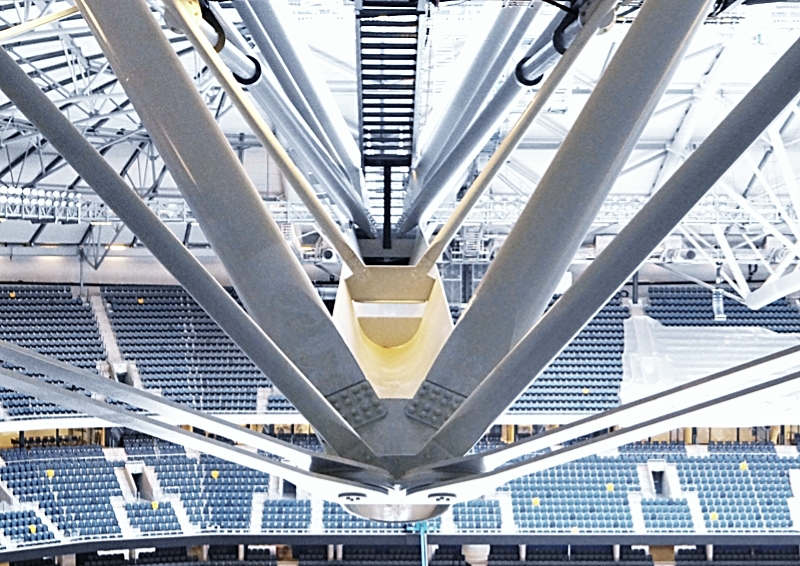Structural design of built assets
Contents |
[edit] Introduction
The structure of a building (or other built asset) – whether framed or non-framed – concerns those parts that are fundamental to its strength, stability and rigidity and which transfer the various loadings (including their self-weight) down to the foundations. This comprises loadbearing or structural primary elements. Structural design is therefore the process of creating a safe, efficient structure in which loads are conveyed safely and efficiently to the foundations and which can withstand prevailing natural forces.
[edit] What structural design may involve
The complexity of many of today’s buildings, especially multi-storey framed buildings, dictates that the structural design should be undertaken by qualified structural engineers who can conceive and produce the requisite calculations that will allow a structure to be built safely.
A successful design for a building involves a structural design that has been integrated with the work of other designers on the project, such as architects and building services engineers. Structural design may also involve supervising the contractor on site concerning items such as placing of reinforcement, pouring concrete, etc.
Engineers undertaking the structural design of a building will need to understand in detail subjects such as applied mathematics and materials science. They will also need knowledge of the applicable design codes and the techniques of structural analysis. Today, much of this knowledge is augmented by specialist drawing, modelling and simulation software which makes the design of structures a more precise – and some might say less onerous – task.
For more information see: Structural engineer.
[edit] Elements of structure
Buildings vary but the following are some of the basic elements that may form part of a building’s structure, whether framed or loadbearing:
[edit] Framed construction (timber, steel or reinforced concrete):
- Roof structure (if present)
- Floors
- Core (if present)
- Horizontal and vertical elements (beams and columns)
- Foundations (ground beams, pile caps, piles etc.)
Cladding is not considered a structural element as generally it is non-loadbearing.
[edit] Loadbearing construction:
[edit] Elements incorporated in a comprehensive structural design can include:
- The underlying geology;
- The properties and behaviour of the soil (e.g ultimate bearing capacity, safeguard against failure by shear etc);
- The possibility of excessive settlement (due to soil consolidation under the foundation, etc);
- Meteorological factors – peak wind intensity and direction etc.
- Likelihood of earthquakes or other natural phenomena.
[edit] Withstanding an array of forces
Engineers must ensure their designs and calculations comply with current regulations and good practice. Structures must be designed to withstand an array of different forces that may act upon them, including:
- Dead load (self weight)
- Live loads: applied weight (imposed load) e.g furnishings, fixtures, fittings, people.
- Environmental loads: wind loads, snow loads, settlement forces, earthquakes etc.
For more infomration see: Types of load.
These loads may result in forces such as: bending moments, shear forces, torsion and so on.
For more information see: Structural principles.
[edit] Communicating the design
Concept design proposals from the structural engineer might include:
- Preferred foundation design.
- Frame system.
- Structural grid with column sizes.
- Primary and secondary beam sizes and spans.
- Schedules of floor loadings catering for dead and live loads.
- Special loads.
- Horizontal and vertical expansion joints.
- Major openings in floors and structural walls.
- Wind bracing elements.
- Typical edge details.
- Fire protection to the structure.
For more information see: Concept structural design.
Following an engineer’s concept design, the next step will usually be the creation of structural plans sections, elevations and specifications indicating:
- The location of all structural elements in relation to gridlines;
- Dimensions and sizes of beams, columns, walls and slabs;
- Sketch details of junctions and proposed fixings;
- Superimposed loading allowances for each floor slab.
- The proposed discipline for all holes through the structure giving the range and sizes permissible;
- An outline specification including total weights of reinforcement;
- Highlighting any changes from the concept design, and
- Provide the services engineer with sufficient information to undertake the services design.
For more information see: Detailed structural design
[edit] Related articles on Designing Buildings Wiki
- Concept structural design.
- Detailed design.
- Elements of structure in buildings.
- Moment.
- Stiffness.
- Structural engineer.
- Structural principles.
- Structural systems for offices.
- Structural vibration.
- Structures at the end of their design life.
- The development of structural membranes.
- Types of structural load.
- Vibrations.
Featured articles and news
Moisture, fire safety and emerging trends in living walls
How wet is your wall?
Current policy explained and newly published consultation by the UK and Welsh Governments.
British architecture 1919–39. Book review.
Conservation of listed prefabs in Moseley.
Energy industry calls for urgent reform.
Heritage staff wellbeing at work survey.
A five minute introduction.
50th Golden anniversary ECA Edmundson apprentice award
Showcasing the very best electrotechnical and engineering services for half a century.
Welsh government consults on HRBs and reg changes
Seeking feedback on a new regulatory regime and a broad range of issues.
CIOB Client Guide (2nd edition) March 2025
Free download covering statutory dutyholder roles under the Building Safety Act and much more.
AI and automation in 3D modelling and spatial design
Can almost half of design development tasks be automated?
Minister quizzed, as responsibility transfers to MHCLG and BSR publishes new building control guidance.
UK environmental regulations reform 2025
Amid wider new approaches to ensure regulators and regulation support growth.
The maintenance challenge of tenements.
BSRIA Statutory Compliance Inspection Checklist
BG80/2025 now significantly updated to include requirements related to important changes in legislation.
Shortlist for the 2025 Roofscape Design Awards
Talent and innovation showcase announcement from the trussed rafter industry.























